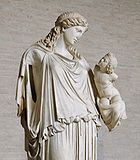
Eirene (Greek goddess)
Encyclopedia

Horae
In Greek mythology the Horae or Hours were the goddesses of the seasons and the natural portions of time. They were originally the personifications of nature in its different seasonal aspects, but in later times they were regarded as goddessess of order in general and natural justice...
, was the personification of peace, and was depicted in art as a beautiful young woman carrying a cornucopia
Cornucopia
The cornucopia or horn of plenty is a symbol of abundance and nourishment, commonly a large horn-shaped container overflowing with produce, flowers, nuts, other edibles, or wealth in some form...
, sceptre
Sceptre
A sceptre is a symbolic ornamental rod or wand borne in the hand by a ruling monarch as an item of royal or imperial insignia.-Antiquity:...
and a torch or rhyton
Rhyton
A rhyton is a container from which fluids were intended to be drunk, or else poured in some ceremony such as libation. Rhytons were very common in ancient Persia, where they were called takuk...
. She is said sometimes to be the daughter of Zeus
Zeus
In the ancient Greek religion, Zeus was the "Father of Gods and men" who ruled the Olympians of Mount Olympus as a father ruled the family. He was the god of sky and thunder in Greek mythology. His Roman counterpart is Jupiter and his Etruscan counterpart is Tinia.Zeus was the child of Cronus...
and Themis
Themis
Themis is an ancient Greek Titaness. She is described as "of good counsel", and is the embodiment of divine order, law, and custom. Themis means "divine law" rather than human ordinance, literally "that which is put in place", from the verb τίθημι, títhēmi, "to put"...
.
She was particularly well regarded by the citizens of Athens. After a naval victory over Sparta
Sparta
Sparta or Lacedaemon, was a prominent city-state in ancient Greece, situated on the banks of the River Eurotas in Laconia, in south-eastern Peloponnese. It emerged as a political entity around the 10th century BC, when the invading Dorians subjugated the local, non-Dorian population. From c...
in 375 BC, the Athenians established a cult for Eirene, erecting altar
Altar
An altar is any structure upon which offerings such as sacrifices are made for religious purposes. Altars are usually found at shrines, and they can be located in temples, churches and other places of worship...
s to her. They held an annual state sacrifice to her after 371 BC to commemorate the Common Peace
Common Peace
Common Peace was the term used in ancient Greece for a peace treaty that simultaneously declared peace between all the combatants in a war. The concept was invented with the Peace of Antalcidas in 387 BC...
of that year and set up a votive statue in her honour in the Agora of Athens
Ancient Agora of Athens
The Ancient Agora of Athens is the best-known example of an ancient Greek agora, located to the northwest of the Acropolis and is bounded on the south by the hill of the Areopagus and on the west by the hill known as the Colonus Agoraeus.-History:The agora in Athens had private housing, until it...
. The statue was executed in bronze by Cephisodotus the Elder
Cephisodotus the Elder
Cephisodotus or Kephisodotos was a Greek sculptor, perhaps the father or an uncle of Praxiteles, one of whose sculptor sons was Cephisodotus the Younger....
, the father of the famous sculptor Praxiteles
Praxiteles
Praxiteles of Athens, the son of Cephisodotus the Elder, was the most renowned of the Attic sculptors of the 4th century BC. He was the first to sculpt the nude female form in a life-size statue...
. It was acclaimed by the Athenians, who depicted it on vases and coins.
Although the statue is now lost, it was copied in marble by the Romans; one of the best surviving copies (right) is in the Munich
Munich
Munich The city's motto is "" . Before 2006, it was "Weltstadt mit Herz" . Its native name, , is derived from the Old High German Munichen, meaning "by the monks' place". The city's name derives from the monks of the Benedictine order who founded the city; hence the monk depicted on the city's coat...
Glyptothek
Glyptothek
The Glyptothek is a museum in Munich, Germany, which was commissioned by the Bavarian King Ludwig I to house his collection of Greek and Roman sculptures . It was designed by Leo von Klenze in the Neoclassical style, and built from 1816 to 1830...
. It depicts the goddess carrying a child with her left arm – Ploutos, the god of plenty and son of Demeter
Demeter
In Greek mythology, Demeter is the goddess of the harvest, who presided over grains, the fertility of the earth, and the seasons . Her common surnames are Sito as the giver of food or corn/grain and Thesmophoros as a mark of the civilized existence of agricultural society...
, the goddess of agriculture. Eirene's missing right hand once held a sceptre. She is shown gazing maternally at Ploutos, who is looking back at her trustingly. The statue is an allegory for Plenty (Ploutos) prospering under the protection of Peace (Eirene); it constituted a public appeal to good sense. The copy in the Glyptothek was originally in the collection of the Villa Albani in Rome but was looted and taken to France by Napoleon I
Napoleon I
Napoleon Bonaparte was a French military and political leader during the latter stages of the French Revolution.As Napoleon I, he was Emperor of the French from 1804 to 1815...
. Following Napoleon's fall, the statue was bought by Ludwig I of Bavaria
Ludwig I of Bavaria
Ludwig I was a German king of Bavaria from 1825 until the 1848 revolutions in the German states.-Crown prince:...
.

